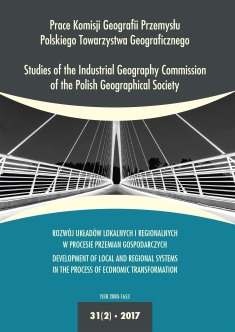The Influence of New Information Technologies in Supply Chains Logistics on Mobility in Urban Areas
DOI:
https://doi.org/10.24917/20801653.312.6Keywords:
industry 4.0, innovations, logistics, mobility, new information technologiesAbstract
Cities are places of countless logistics processes, i.e. the processes of flow of all kinds of resources: human, material, information. The basic problem of contemporary cities are factors limiting their sustainable development. Most of them originate from excessive congestion caused by individual motorization and road freight transport. In recent years, supply chains intensively develop and implement new information technologies. That aims at rationalizing the business logistics processes by improving the information flows which is followed by reducing the demand for physical resources and the reduction of processing time and costs. Because the cities are large areas of logistics processes related to the economic activities of enterprises, the purpose of this article is to answer the following question: how do new information technologies, used in logistics processes, influence the structure of resources mobility in urban areas and how they can help in solving problems of congestion in urban areas. The main assumption of the study is that information flows can partially substitute real flows, which leads to the main thesis of the research that new technologies which streamline the flows of information in B2B and B2C relation can reduce the demand for goods and human flows within the cities. That rationalization translates into changes of resources demand structure and thus a change in demand for their mobility. The study used analysis and deduction method based on the literature and real life examples in the field of information technology which are already in use and those that can be used soon in logistics processes. This field of research is underdeveloped because logisticians focus their research on economization of business logistics processes and do not pay much attention to how they can influence urban areas.
Downloads
Metrics
References
Ahmad, A., Rathore, M.M., Paul, A., Rho, S. (2016). Defining Human Behaviors using Big Data Analytics in Social Internet of Things. 2016 IEEE 30th International Conference on Advanced Information Networking and Applications. DOI: 10.1109/AINA.2016.104
Britchnell, T., Urry, J., Cook, C., Curry, A. (2016, 19 December). Freight Miles. The Impact of 3D Printing on transport and Society. Access at http://eprints.lancs.ac.uk/66198/1/Freight_ Miles_Report.pdf
Bujak, A. (2016). Rewolucja 4.0 i jej wpływ na łańcuch dostaw. Conference presentation at XVII Konferencja Naukowa Modelowanie procesów i systemów logistycznych, 1–2 December, Sopot, Poland.
Chaberek, M. (2002). Makro- i mikroekonomiczne aspekty wsparcia logistycznego. Gdańsk: Wydawnictwo Uniwersytetu Gdańskiego.
Chaberek, M. (2011). Praktyczny wymiar teorii logistyki. Roczniki Naukowe Wyższej Szkoły Bankowej w Toruniu, 10(10), 209–218.
Chaberek, M., Karwacka, G. (2012). Railway interoperability as a factor of developing transportation flows 21th century supply chains. In: J. Szołtysek (ed.). Developing of Transportation Flows in 21th century Supply Chains. Studia Ekonomiczne. Zeszyty Naukowe Wydziałowe Uniwersytetu Ekonomicznego w Katowicach, 121, 85–98.
Chaberek-Karwacka, G. (2012). Logistyczne narzędzia wdrażania strategii CSR w łańcuchach dostaw. Roczniki Naukowe Wyższej Szkoły Bankowej w Toruniu, 11(11), 417–432.
Fiorello, D., Martino, A., Zani, L., Christidis, P., Navajas-Cawood, E. (2016). Mobility data across the EU 28 member states: results from an extensive CAWI survey. Transportation Research Procedia, 14, 1104–1113.
Future Supply Chain 2020. Building strategies for the new decade. (2012). Report GCI, Capgemini.
Access at http://www.theconsumergoodsforum.com/files/Publications/2020-Future- Value-Chain-Report.pdf Gdańskie badanie ruchu 2016 wraz z opracowaniem transportowego modelu symulacyjnego Gdańska (2016, 10 December). Biuro Rozwoju Gdańska. Access at http://www.brg.gda.pl/ doc/przetarg/151222_zalacznik_1.pdf
Hecklaua, F., Galeitzkea, M., Flachsa, S., Kohlb, H. (2016). Holistic approach for human resource management in Industry 4.0. Procedia CIRP, 54, 1–6.
Kawa, A. (2011). Konfigurowanie łańcucha dostaw. Teoria, instrumenty i technologie. Poznań: Wydawnictwo Uniwersytetu Ekonomicznego w Poznaniu.
Maksimovic, M., Gavrilovic, Z. (2016). Connecting Sciences in Green: Internet Of Things And Economy. Conference Paper at Conference: ENTECH ‘16/IV. International Energy Technologies Conference, Turkey: Istanbul.
Marré, M., Beihofer, D., Haggenmüller, W., Grupp, Ph. (2016, 19 December). Forming for Resource- Efficient Industry 4.0. Conference Paper. Access at https://www.researchgate.net/publication/ 283715941_Forming_for_Resource-Efficient_Industry_40
Mihailovic, A. (2016). Liberalising Deployment of Internet of Things Devices and Services in Large Scale Environments. Wireless Personal Communications. Access at Springerlink.com. DOI: 10.1007/s11277-016-3837-0
Molenaar, C. (2013). The End of Shops. Social Buying and the Battle for the Customer. Farnham: GOWER.
Molenaar, C. (2015). Why Customers Would Rather Have a Smartphone than a Car. Relationship retailing as an Opportunity. Farnham: GOWER.
Moore, M.A. (2016). 3D Printing & Cargo; Treat or opportunity. Air Cargo World, 106(4), 22–24.
Piskozub, A. (red.) (1979). Ekonomika transportu. Warszawa: Wydawnictwa Komunikacji i Łączności.
Qina, J., Liua, Y., Grosvenora, R. (2016). A Categorical Framework of Manufacturing for Industry 4.0 and Beyond, Changeable, Agile, Reconfigurable & Virtual Production. Procedia CIRP, 52, 173–178.
Sipsas, K., Alexopoulos, K., Xanthakis, V., Chryssolouris, G. (2016). Collaborative maintenance in flow-line manufacturing environments: An Industry 4.0 approach. Procedia CIRP, 55, 236– 241.
Special issue – City Logistics (2004). European TransportTrasporti Europei, 28, 1–5. Access at https://www.openstarts.units.it/dspace/bitstream/10077/5852/1/ET28.pdf
Stock, T., Seliger, G. (2016). Opportunities of Sustainable Manufacturing in Industry 4.0. Procedia CIRP, 40, 536–541.
Szołtysek, J. (2011). Kreowanie mobilności mieszkańców miast. Warszawa: Wolters Kluwer Polska.
Szozda, N., Świerczek, A. (2016). Znaczenie Internetu rzeczy (IoT) w planowaniu przepływów produktów i informacji w łańcuchu dostaw. Conference presentation at XVII Konferencja Naukowa Modelowanie procesów i systemów logistycznych, 1–2 December, Sopot, Poland.
Thomas, D.J. (2016). 3D Printing. In: J. Izdebska, D.J. Thomas D.J (ed.). Printing on Polymers. Fundamentals and Applications, 293–306. DOI: 10.1016/B978-0-323-37468-2.00018-X
Urban Agenda for the EU. Pact of Amsterdam (2016, 19 December). Access at http://urbanagendaforthe.eu/wp-content/uploads/2016/05/Pact-of-Amsterdam_v7_WEB.pdf
Ye, M. (2015). The Impact Of 3d Printing on The World Container Transport. Master of Transport, Infrastructure and Logistics Delft University of Technology. Access at: Delft University of Technology: Institutional Repository
Z fotela w samochodzie na rowerowe siodełko Duńczycy przesiadają się z własnej woli. (2016, 21 December). Access at http://www.miasto2077.pl/z-fotela-w-samochodzie-na-rowerowesiodelko- dunczycy-przesiadaja-sie-z-wlasnej-woli/
Zioło, Z. (2012). Position of innovativeness in the processes of economic development of spatial structures. Studies of the Industrial Geography Commission of the Polish Geographical Society, 20, 9–32.
Downloads
Published
How to Cite
Issue
Section
License
Articles are published under the terms of the Creative Commons License (CC BY-ND 4.0; Attribution– NoDerivs).

